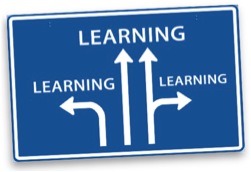 |
|
February 2019
Volume 15, Issue 2
These are free monthly tips on boosting
business and professional results.
Start your subscription!
To change subscription options, please
see the bottom of the page.
 Like us on Facebook! Like us on Facebook!
|
|
Greetings!
Below find this month’s newsletter, hot off the press!
Please add “Adele@LearnShareProsper.com” to your whitelist or address book in your e-mail program,
so that you have no trouble receiving future issues.
You subscribed to this newsletter at LearnShareProsper.com. You’re very welcome to forward it to your
colleagues; please just keep the entire message intact.
If you wish to discontinue your subscription, please
use the links at the bottom.
|
|
 |
|
How Should Managers Set the Conditions for Success?
 Today’s issue is devoted to examining the roles that management can and should be playing in ensuring that any training — and other types of improvement interventions — produce the best possible results. Rather than leaving success to chance, managers and employees can jointly and collaboratively bring about a positive outcome! Today’s issue is devoted to examining the roles that management can and should be playing in ensuring that any training — and other types of improvement interventions — produce the best possible results. Rather than leaving success to chance, managers and employees can jointly and collaboratively bring about a positive outcome!
The better management sets the conditions for success by engineering training experiences, the more readily employees can apply what they learn in a way that fully benefits the team, work unit, department, or organization.
This means that management must proactively anticipate and orchestrate what is supposed to occur before, during, and after the training to make the training “stick.”
Have you ever experienced the letdown of embarking on an expensive and time-consuming training program, only to see it lose steam somewhere along the way? The last thing you’d want to see happen is to have all of the time, effort, and cost wasted because the follow-up fell through, or because a critical step didn’t receive enough attention.
For these reasons, I hope you enjoy today’s features (including Part 1 of a series on making training stick). Be sure to share leave your comments on my Facebook page!
Here’s to your business prosperity,

Adele Sommers, Ph.D., business improvement specialist, author, educator, and award-winning instructional designer
P.S. If you missed any previous issue, please visit
the newsletter archive!
|
|

|
|
Is Your Managerís Attitude Affecting Your Health?

According a classic Swedish study, incompetent and badly behaved bosses make work stressful, and also increase the risk of heart disease for their staff. The study — published in the journal Occupational and Environmental Medicine — had concluded that when an employee routinely feels undervalued and unsupported, the related stress can trigger the unhealthy behaviors that lead to heart disease.
The articipants rated their senior managers by grading them on several dimensions, such as how well they communicated clear expectations, work goals, objectives, relevant job information, and feedback; how often they offered empathy and encouragement; their ability to successfully push through and carry out changes; and whether they delegated sufficient authority for employees to carry out their responsibilities.
Per the abstract, the “Swedish team found a strong link between poor leadership and the risk of serious heart disease and heart attacks among more than 3,000 employed men. And the effect may be cumulative — the risk went up the longer an employee worked for the same company. . . . The staff who deemed their senior managers to be the least competent had a 25 per cent higher risk of a serious heart problem. And those working for what was classed as a long time — four years or more — had a 64 per cent higher risk.”
 What benefits do good managers impart? Per Anna Nyberg of the Karolinska Institute and the Stress Research Institute at Stockholm University: What benefits do good managers impart? Per Anna Nyberg of the Karolinska Institute and the Stress Research Institute at Stockholm University:
“One could speculate that a present and active manager, providing structure, information, and support, counteracts destructive processes in work groups, thereby promoting regenerative rather than stress-related physiological processes in employees.” Those sound like desirable health benefits to me!
Source: A. Nyberg and others. Managerial leadership and ischaemic heart disease among employees: the Swedish WOLF study, Occupational and Environmental Medicine |
|
 |
Tips on Making Training Stick (Part 1)
by Adele Sommers
Training is a powerful improvement technique that offers tremendous benefits when judiciously used. The downside is that training represents an expensive and ephemeral way to close a “performance gap” in an organization. Here’s why:
- It’s expensive because it takes people away from their regular work and often involves development, logistics, and support costs.
- It’s ephemeral because of its fragile, short life span within people’s brains, which is why learners need considerable follow-up support to make real use of what they learn.
 In previous articles, I’ve explained that the purpose of training is providing the conceptual and procedural information that people need to perform effectively in their jobs. Training is most effective if the employees’ talents are a good fit for their roles. In previous articles, I’ve explained that the purpose of training is providing the conceptual and procedural information that people need to perform effectively in their jobs. Training is most effective if the employees’ talents are a good fit for their roles.
You would use training only when needed to bridge a true knowledge gap. (There are many situations in which training might not be an appropriate tool, such as when people already have enough job knowledge, but are being impeded by work hurdles or hassles.)
This article, the first in a series, discusses management’s role in supporting the many factors that influence how well people can transfer and use on the job any training they receive.
Transferring Training to the Job Requires More than Luck
 The term “transfer of training” refers to the ability of learners to apply their new knowledge and skills to real-world situations, particularly in the workplace. The term “transfer of training” refers to the ability of learners to apply their new knowledge and skills to real-world situations, particularly in the workplace.
If trainees cannot apply what they have learned to their jobs, their training time and investment will have been wasted!
Training-transfer “success factors” are the keys to hitting a “training home run” that results in greater proficiency, speed, accuracy, quality, or any other desirable, job-related outcomes. These factors include, but are not limited to:
- How mission-based the training purpose is
- Learners’ attitudes toward the training process
- The design and relevance of instructional materials
- The presence or absence of obstacles to productivity
- Whether job conditions support and encourage the desired outcomes
- Whether the budget and schedule allow learners to practice new skills
- The availability of necessary tools, resources, equipment, and job aids
- The level of management support for the immediate use of the training
- The amount of post-training motivation, practice, and guidance provided
Below are the first two of four critical steps managers can take to ensure that training transfer occurs!
Step 1: Determine Organizational Needs that Require Training
 Training programs are most effective when they directly address actual organizational problems and opportunities. These are justifiable, real-world reasons for asking for an employee’s time, focus, and effort. Training programs are most effective when they directly address actual organizational problems and opportunities. These are justifiable, real-world reasons for asking for an employee’s time, focus, and effort.
Whenever it becomes clear that training would support a compelling organizational need, learners will take it more seriously. And, it will be far easier to sustain as well as calculate a return on investment.
So, to be sure that new training is highly relevant to your organization’s mission and goals, you will want to identify the related critical business issues in terms of:
- Problems: For example, a high rate of customer complaints, dwindling sales, the risk of losing certification, or poor product quality
- Opportunities: For example, expanding into new markets, improvements to products or processes to boost profitability, anticipated regulatory changes, or achieving industry certifications
Next, answer the following with regard to the identified problems or opportunities:
- What outcomes should this training produce? Sample outcomes include increased product sales, decreased customer complaints, better designs of process experiments, more accurate defect analysis summaries, supervisors regularly coaching their employees.
- What projects, products, or processes would the training pertain to? Example: The assembly process for part 456 on the satellite project.
- What risks would surface if the identified outcomes were delayed?
For example, would there be an imminent loss involving a safety hazard, a product failure, or customer departure? Or could a critical product rollout be delayed, a certification requirement missed, or a planned repositioning in the marketplace stalled?
- What alternatives to the instruction exist, if any? Can you satisfy the need for improvement using other approaches, instead of, or in addition to, training? You might discover through this analysis that training is not the answer, or is only part of the answer, if people are experiencing other types of obstacles to success.
Step 2: Carefully Plan the Instructional Experience
Next, it’s time to engineer and orchestrate the training cycle from beginning to end (including how learners will apply the training on the job and continuously improve the processes they work with). To do this, start by identifying and describing the key elements of the training in the areas listed below:
 Identify a training objective for each outcome or desired achievement level. Training objectives involve three parts: a condition, an action, and a standard or criterion. Identify a training objective for each outcome or desired achievement level. Training objectives involve three parts: a condition, an action, and a standard or criterion.
For example, “Given a new customer who is calling with questions [a condition], be able to provide fast and accurate product information [an action] to comply with all of the standards on the customer support checklist [a criterion].”
- List any pre-course assignments that learners must complete. For example, list required readings, exercises, assessments, and surveys.
- Identify the time commitments before, during, and after training. Example: Activities before instruction might require 10 hours to complete; the commitment during instruction might require 30 hours; and practice, support, and evaluation sessions afterward might require up to 40 hours.
- List reference aids and materials that learners will receive. For example, list manuals, tools, textbooks, procedures, and quick reference guides.
The next critical piece involves having the employee and supervisor or manager complete a learning contract, such as the sample below, to spell out all of the commitments each is making to help ensure optimal learning. Use a separate contract for each employee.
Note: This is one of two contracts that apply to the full training cycle. The second contract appears in Part 2 of this series, and pertains to facilitating and supporting the use of the training back on the job.
LEARNING CONTRACT
Employee’s Commitment:
I, ________________________, wish to receive the following instruction:
______________________________. If chosen to participate, I agree to:
- Complete and return all pre-course assignments on time.
- Attend and actively participate in all course sessions.
- Keep an “ideas and applications notebook” or write an action plan.
- Discuss the applications ideas or action plan with my supervisor.
- Share highlights of the program with my work team (e.g., at staff meetings).
- Participate in all follow-up practice, support, and evaluation sessions.
Signed________________________
Date__________________________
Supervisor’s (or Manager’s) Commitment:
I, ____________________, supervisor of the above employee, agree to:
- Participate in all planning, needs analysis, and/or briefing sessions.
- Release the employee from work assignments to enable participation in all sessions and assignments before, during, and after instruction.
- Minimize interruptions to the instructional process.
- Discuss “ideas and applications notebooks” and/or action plans with the employee.
- Encourage the employee to share highlights of the program with the work team.
- Model skills, coach the employee, and/or provide specific occasions for practice and integration of the new skills into the employee’s job.
Signed________________________
Date__________________________
Adapted from M. Broad & J. Newstrom (1992). Transfer of Training. |
In conclusion, management should take the lead role in establishing a compelling training need, as well as requesting a mutual commitment with each trainee. Part 2 (to appear next month) will explore several additional steps that managers should take to help employees successfully integrate what they’ve learned into their jobs.
Copyright 2019 Adele Sommers
|
|
 |
|
“Guide to Boosting Productivity and Effectiveness”

Are you looking for a cookbook of great ideas for boosting your staff’s capabilities, eliminating hassles, streamlining procedures, and developing cutting-edge processes?
My Productivity
Success Kit offers a compendium of “how-to” techniques for increasing your organizational effectiveness.
This comprehensive special report includes 36 pages of tips, best practices, checklists, and worksheets that will help your business gain a potent competitive advantage! |
|
 |
|
Adele Sommers, Ph.D. is the author of “Straight
Talk on Boosting Business Performance” — an award-winning
Special Report and Workbook program.
If you liked today’s issue, you’ll love this down-to-earth
overview of how 12 potent business-boosting strategies
can reenergize the morale and productivity of your enterprise,
tame unruly projects, and attract loyal, satisfied customers.
It’s accompanied by a step-by-step workbook designed
to help you easily create your own success action plan.
Browse the table of contents and reader reviews on the
description page.
Adele also offers no-cost articles and resources to
help small businesses and large organizations accelerate
productivity and increase profitability. Learn more
at LearnShareProsper.com.
LearnShareProsper.com/Business Performance_Inc.,
705 North State Street #187, Ukiah, California,
USA.
For more information, e-mail Info@LearnShareProsper.com. |
|
|
|
| |
|
©2019
Business Performance_Inc., Adele Sommers, All rights
reserved. www.LearnShareProsper.com
Your feedback is always appreciated!
Write to us at info@LearnShareProsper.com.
We respect your privacy and do not give out or sell
subscriber names or e-mail addresses.
Please use the links below to take
yourself off our list or change your e-mail address.
|
|
|


